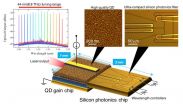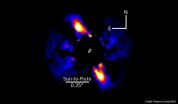(Press-News.org) BOSTON - A new study from researchers at Beth Israel Deaconess Medical Center (BIDMC) suggests that risk factors for readmission change significantly over the course of the 30 days following hospital discharge. Thirty-day hospital readmission rates have become a federal quality metric intended to reflect inpatient quality of care and unnecessary health care utilization.
Published today in the Annals of Internal Medicine, the research suggests that two distinct 8-day and 30-day readmission rates would serve as better inpatient quality measurements and would better inform readmission prevention strategies.
A review of more than 13,000 discharges involving more than 8,000 patients in 2009 and 2010 found that early readmissions (0-7 days post discharge) were associated with markers of the acute illness managed during initial hospitalization. A patient's chronic illness burden was more important in predicting late readmissions (8-30 days post discharge).
"Our research found that risk factors for readmission evolved during the first 30 days following hospital discharge," said lead author Kelly L. Graham, MD, MPH, a physician in the Division of General Medicine and Primary Care at BIDMC and an Instructor in Internal Medicine at Harvard Medical School (HMS). "Readmissions in the first week were more highly associated with factors related to the initial hospitalization than later readmissions. These findings suggest that the standard 30-day metric does not accurately reflect hospitals' accountability for readmissions."
The authors also note that other research has shown hospitals that strictly follow evidence-based care standards do not necessarily have the lowest readmission rates and that readmission rates do not serve as a benchmark to inpatient mortality. Under the Affordable Care Act, the Centers for Medicare and Medicaid Services (CMS) may reduce payments to acute care hospitals deemed to have excess readmissions within 30 days of discharge.
The study also found that discharge between 8 a.m. and 12:59 p.m. was associated with lower odds of an early readmission. The authors note that discharge in the first part of the day likely enables patients and their families more time to access community resources such as pharmacies and social supports, thus reducing the likelihood of readmission.
The authors also found that social determinants of health are closely tied to readmissions, as they impact how patients access care. They evaluated the impact of barriers to health literacy on readmissions and found that they were associated with both early and late readmissions. Insurance status was also relevant among patients readmitted in the late period; patients with unsupplemented Medicare or Medicaid were more likely to be readmitted eight or more days after discharge.
"The growing movement toward accountable care organizations and patient-centered medical homes may prove beneficial in preventing unnecessary hospital readmissions," Graham added. "Patients discharged from the hospital need support from and teamwork among hospitalists, primary care physicians, nurse practitioners, visiting nurses, pharmacists and others."
The authors stressed that both hospital and outpatient settings need systems of care that closely monitor patients as they transition their medical care from the hospital team back to the primary care team. Post-discharge monitoring would better enable a team to make sure patients adhere to the detailed care plan designed by the hospital team, such as taking medications correctly and keeping follow-up appointments.
INFORMATION:
In addition to Graham, co-authors include: Elissa H. Wilker, ScD, Cardiovascular Epidemiology Research Unit at BIDMC; Michael D. Howell, MD, MPH, Center for Quality and the Section of Pulmonary and Critical Care, University of Chicago; Roger B. Davis, ScD, Division of General Medicine and Primary Care, Department of Medicine, BIDMC and HMS; and Edward R. Marcantonio, MD, SM, Division of Gerontology, Department of Medicine, BIDMC and HMS.
The study was funded the Health Resources and Services Administration training grant [T31 HP12706], a Midcareer Investigator Award in Patient-Oriented Research from the National Institutes of Health [K24 AG035075; NIH K99 ES022243]; Harvard Catalyst [NIH Award #UL1 TR001102-01] and financial contributions from Harvard University and its affiliated academic health care centers.
Beth Israel Deaconess Medical Center is a patient care, teaching and research affiliate of Harvard Medical School and consistently ranks as a national leader among independent hospitals in National Institutes of Health funding.
BIDMC is in the community with Beth Israel Deaconess Hospital-Milton, Beth Israel Deaconess Hospital-Needham, Beth Israel Deaconess Hospital-Plymouth, Anna Jaques Hospital, Cambridge Health Alliance, Lawrence General Hospital, Signature Healthcare, Beth Israel Deaconess HealthCare, Community Care Alliance and Atrius Health. BIDMC is also clinically affiliated with the Joslin Diabetes Center and Hebrew Senior Life and is a research partner of Dana-Farber/Harvard Cancer Center and The Jackson Laboratory. BIDMC is the official hospital of the Boston Red Sox. For more information, visit http://www.bidmc.org.
The scientific team, from the Institute for Basic Science (IBS) and Seoul National University, has developed an ultra-thin wearable quantum dot light emitting diodes (QLEDs). The electronic tattoo is based on current quantum dot light emitting diode (QLED) technology. Colloidal quantum dot (QLED's) have attracted great attention as next generation displays. The quantum dots (QDs) have unique properties such as the color tunability, photo/air stability, and are printability on various substrates. The device is paper thin and can be applied to human skin like a sticker.
The ...
To arrange for an interview with a researcher, please contact the Communications staff member identified at the end of each tip. For more information on ORNL and its research and development activities, please refer to one of our media contacts. If you have a general media-related question or comment, you can send it to news@ornl.gov.
SOLAR - Suitability mapping ...
Using remote sensing data, researchers can efficiently determine optimum sites for solar power plants, according to a study led by Olufemi Omitaomu of Oak Ridge National Laboratory. With the target of solar ...
University of Adelaide researchers have discovered cerebral palsy has an even stronger genetic cause than previously thought, leading them to call for an end to unnecessary caesareans and arbitrary litigation against obstetric staff.
In an authoritative review published in the American Journal of Obstetrics & Gynecology, members of the Australian Cerebral Palsy Research Group, based at the University of Adelaide's Robinson Research Institute, argue that up to 45% of cerebral palsy cases can have genetic causes.
This builds on research published in February this year ...
A study of marine mammals and other protected species finds that several once endangered species, including the iconic humpback whale, the northern elephant seal and green sea turtles, have recovered and are repopulating their former ranges.
The research, published in the June edition of Trends in Ecology and Evolution, suggests that some species, including humpback whales, have reached population levels that may warrant removal from endangered species lists.
But returning species, which defy global patterns of biodiversity loss, create an urgent new challenge for policymakers ...
Researchers at Tohoku University and the National Institute of Information and Communications Technology (NICT) in Japan, have developed
a novel ultra-compact heterogeneous wavelength tunable laser diode. The heterogeneous laser diode was realized through a combination
of silicon photonics and quantum-dot (QD) technology, and demonstrates a wide-range tuning-operation.
The researchers presented their work at a Conference on Lasers and Electro-Optics (CLEO) in San Jose, California, on May 13. The related
paper was also be published in Applied Physics Express ...
A research group at Tohoku University has succeeded in fabricating an atomically thin, high-temperature superconductor film with a superconducting transition temperature (Tc) of up to 60 K (-213°C). The team, led by Prof. Takashi Takahashi (WPI-AIMR) and Asst. Prof. Kosuke Nakayama (Dept. of Physics), also established the method to control/tune the Tc.
This finding not only provides an ideal platform for investigating the mechanism of superconductivity in the two-dimensional system, but also paves the way for the development of next-generation nano-scale superconducting ...
An international team led by Thayne Currie of the Subaru Telescope and using the Gemini South telescope, has discovered a young planetary system that shares remarkable similarities to our own early solar system. Their images reveal a ring-like disk of debris surrounding a Sun-like star, in a birth environment similar to the Sun's. The disk appears to be sculpted by at least one unseen solar system-like planet, is roughly the same size as our solar system's Edgeworth-Kuiper Belt (commonly called the Kuiper Belt), and may contain dust and icy particles. This work provides ...
Using a brand new survey method, researchers in Bergen have asked a broad spectrum of people in Norway about their thoughts on climate change. The answers are quite surprising.
Some 2,000 Norwegians have been asked about what they think when they hear or read the words "climate change". There were no pre-set answers or "choose the statement that best describes your view" options. Instead the respondents had to formulate their views on climate change in their own words. The answers have provided striking new insight into what the average person on the street in Norway ...
Long-term changes in immune function caused by childhood trauma could explain increased vulnerability to a range of health problems in later life, according to new research by the Institute of Psychiatry, Psychology & Neuroscience (IoPPN) at King's College London and the NIHR Maudsley BRC.
The study, published today in Molecular Psychiatry, found heightened inflammation across three blood biomarkers in adults who had been victims of childhood trauma. High levels of inflammation can lead to serious and potentially life-threatening conditions such as type-2 diabetes, cardiovascular ...
Treatment options for chronic hepatitis C, a serious and life-threatening infection, have improved substantially and several new regimens with shorter durations and improved efficacy and safety profiles are now available.
Groups have raised concerns about the evidence used to support the approval of some newer drugs, however, and the issue has been used to cast doubt on their efficacy and even to question treatment or deny reimbursement.
To address these concerns, the US Food and Drug Administration's Division of Antiviral Products in the Center for Drug Evaluation ...




